ENG 1102 - Winter Term: Urban Sprawl Problem Statements Report
VerifiedAdded on 2022/08/15
|8
|2136
|21
Report
AI Summary
This research paper delves into the complexities of urban sprawl in the suburban areas of Canada, presenting a detailed analysis of its contributing factors. The paper begins by defining urban sprawl and then identifies several key problem statements, including population growth, health issues related to air quality and traffic, the high cost of living in urban centers, and traffic congestion. The core of the paper lies in the application of the SCAMPER technique to generate ten distinct solutions to these problems. These solutions range from birth control to urban redevelopment, the construction of affordable housing, modified transport means, the use of technology for remote work, raising awareness of urban sprawl issues, smart growth initiatives, investing in efficient transport, new urbanism, and adaptive reuse of existing structures. Each solution is described in terms of the problem it addresses, the SCAMPER technique used, and the advantages and disadvantages associated with its implementation. The report concludes by summarizing the major aspects contributing to urban sprawl and the effectiveness of proposed solutions.
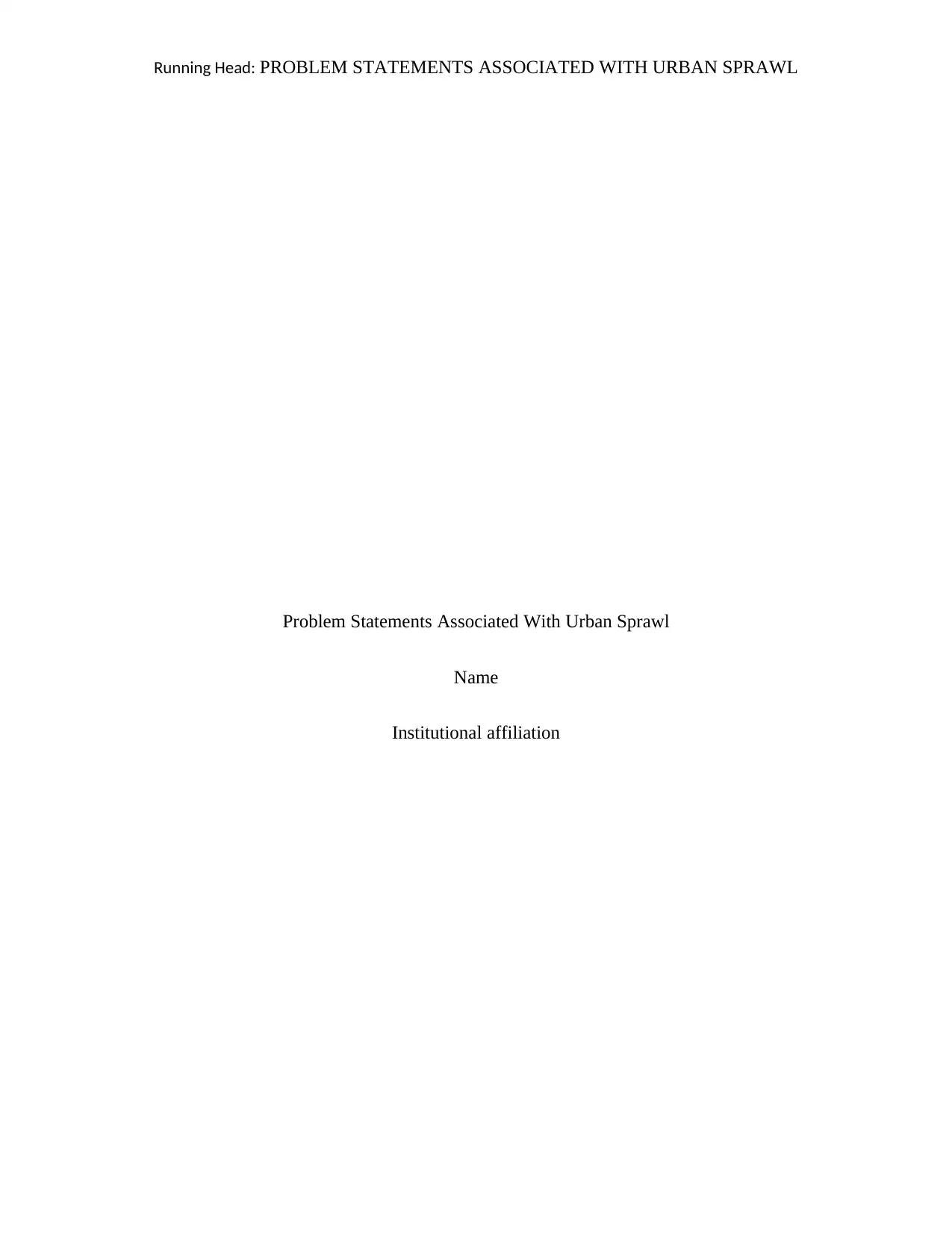
Running Head: PROBLEM STATEMENTS ASSOCIATED WITH URBAN SPRAWL
Problem Statements Associated With Urban Sprawl
Name
Institutional affiliation
Problem Statements Associated With Urban Sprawl
Name
Institutional affiliation
Paraphrase This Document
Need a fresh take? Get an instant paraphrase of this document with our AI Paraphraser
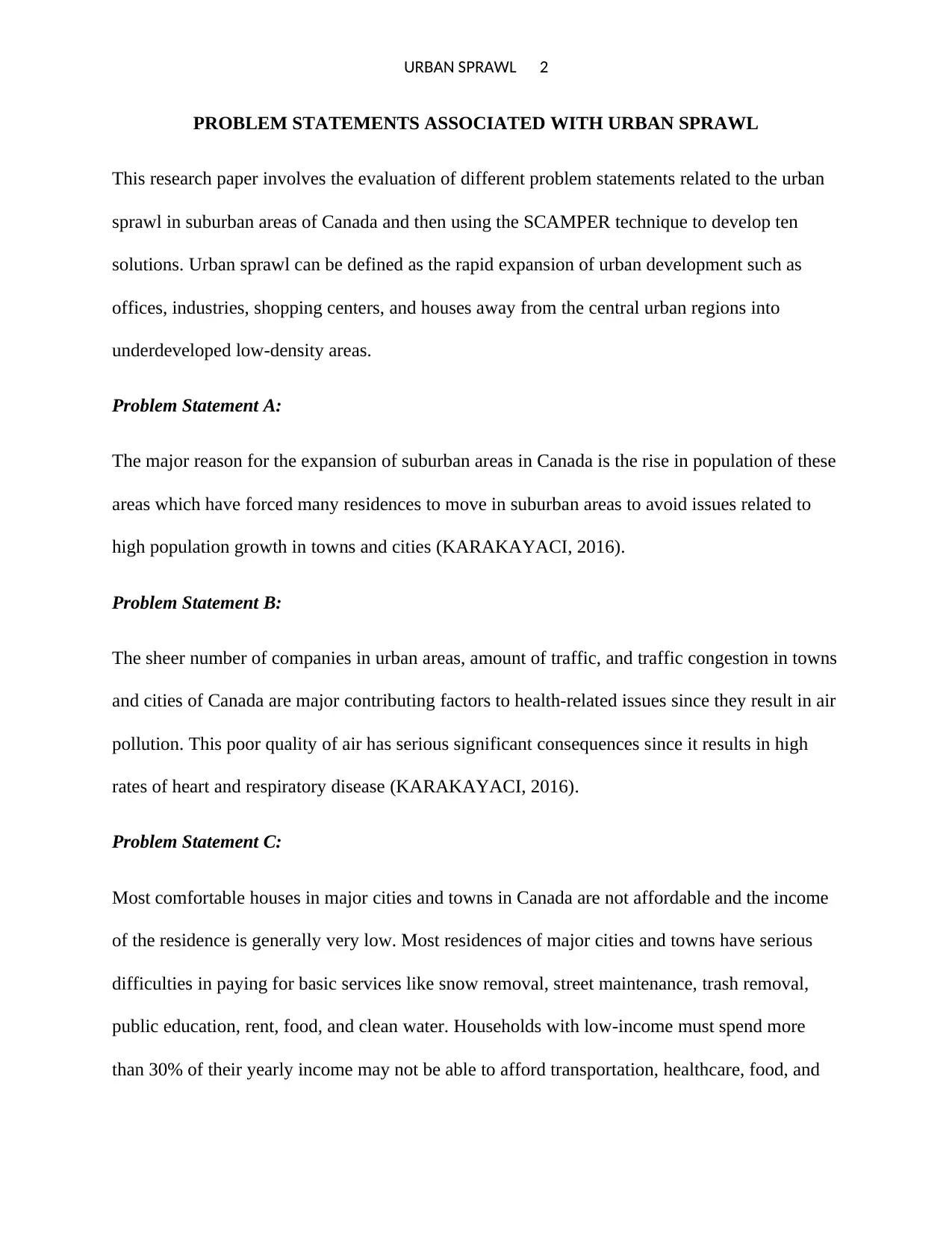
URBAN SPRAWL 2
PROBLEM STATEMENTS ASSOCIATED WITH URBAN SPRAWL
This research paper involves the evaluation of different problem statements related to the urban
sprawl in suburban areas of Canada and then using the SCAMPER technique to develop ten
solutions. Urban sprawl can be defined as the rapid expansion of urban development such as
offices, industries, shopping centers, and houses away from the central urban regions into
underdeveloped low-density areas.
Problem Statement A:
The major reason for the expansion of suburban areas in Canada is the rise in population of these
areas which have forced many residences to move in suburban areas to avoid issues related to
high population growth in towns and cities (KARAKAYACI, 2016).
Problem Statement B:
The sheer number of companies in urban areas, amount of traffic, and traffic congestion in towns
and cities of Canada are major contributing factors to health-related issues since they result in air
pollution. This poor quality of air has serious significant consequences since it results in high
rates of heart and respiratory disease (KARAKAYACI, 2016).
Problem Statement C:
Most comfortable houses in major cities and towns in Canada are not affordable and the income
of the residence is generally very low. Most residences of major cities and towns have serious
difficulties in paying for basic services like snow removal, street maintenance, trash removal,
public education, rent, food, and clean water. Households with low-income must spend more
than 30% of their yearly income may not be able to afford transportation, healthcare, food, and
PROBLEM STATEMENTS ASSOCIATED WITH URBAN SPRAWL
This research paper involves the evaluation of different problem statements related to the urban
sprawl in suburban areas of Canada and then using the SCAMPER technique to develop ten
solutions. Urban sprawl can be defined as the rapid expansion of urban development such as
offices, industries, shopping centers, and houses away from the central urban regions into
underdeveloped low-density areas.
Problem Statement A:
The major reason for the expansion of suburban areas in Canada is the rise in population of these
areas which have forced many residences to move in suburban areas to avoid issues related to
high population growth in towns and cities (KARAKAYACI, 2016).
Problem Statement B:
The sheer number of companies in urban areas, amount of traffic, and traffic congestion in towns
and cities of Canada are major contributing factors to health-related issues since they result in air
pollution. This poor quality of air has serious significant consequences since it results in high
rates of heart and respiratory disease (KARAKAYACI, 2016).
Problem Statement C:
Most comfortable houses in major cities and towns in Canada are not affordable and the income
of the residence is generally very low. Most residences of major cities and towns have serious
difficulties in paying for basic services like snow removal, street maintenance, trash removal,
public education, rent, food, and clean water. Households with low-income must spend more
than 30% of their yearly income may not be able to afford transportation, healthcare, food, and
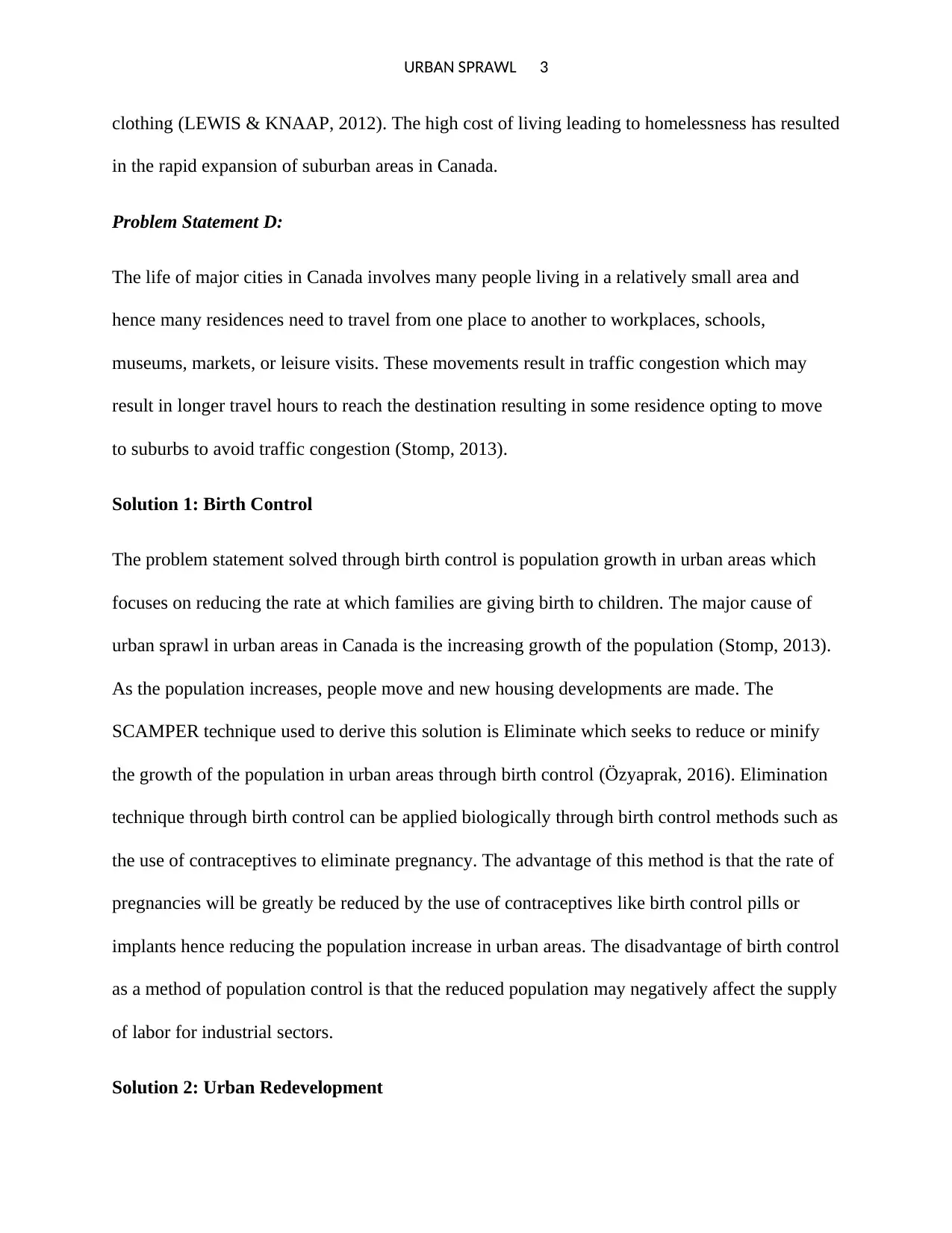
URBAN SPRAWL 3
clothing (LEWIS & KNAAP, 2012). The high cost of living leading to homelessness has resulted
in the rapid expansion of suburban areas in Canada.
Problem Statement D:
The life of major cities in Canada involves many people living in a relatively small area and
hence many residences need to travel from one place to another to workplaces, schools,
museums, markets, or leisure visits. These movements result in traffic congestion which may
result in longer travel hours to reach the destination resulting in some residence opting to move
to suburbs to avoid traffic congestion (Stomp, 2013).
Solution 1: Birth Control
The problem statement solved through birth control is population growth in urban areas which
focuses on reducing the rate at which families are giving birth to children. The major cause of
urban sprawl in urban areas in Canada is the increasing growth of the population (Stomp, 2013).
As the population increases, people move and new housing developments are made. The
SCAMPER technique used to derive this solution is Eliminate which seeks to reduce or minify
the growth of the population in urban areas through birth control (Özyaprak, 2016). Elimination
technique through birth control can be applied biologically through birth control methods such as
the use of contraceptives to eliminate pregnancy. The advantage of this method is that the rate of
pregnancies will be greatly be reduced by the use of contraceptives like birth control pills or
implants hence reducing the population increase in urban areas. The disadvantage of birth control
as a method of population control is that the reduced population may negatively affect the supply
of labor for industrial sectors.
Solution 2: Urban Redevelopment
clothing (LEWIS & KNAAP, 2012). The high cost of living leading to homelessness has resulted
in the rapid expansion of suburban areas in Canada.
Problem Statement D:
The life of major cities in Canada involves many people living in a relatively small area and
hence many residences need to travel from one place to another to workplaces, schools,
museums, markets, or leisure visits. These movements result in traffic congestion which may
result in longer travel hours to reach the destination resulting in some residence opting to move
to suburbs to avoid traffic congestion (Stomp, 2013).
Solution 1: Birth Control
The problem statement solved through birth control is population growth in urban areas which
focuses on reducing the rate at which families are giving birth to children. The major cause of
urban sprawl in urban areas in Canada is the increasing growth of the population (Stomp, 2013).
As the population increases, people move and new housing developments are made. The
SCAMPER technique used to derive this solution is Eliminate which seeks to reduce or minify
the growth of the population in urban areas through birth control (Özyaprak, 2016). Elimination
technique through birth control can be applied biologically through birth control methods such as
the use of contraceptives to eliminate pregnancy. The advantage of this method is that the rate of
pregnancies will be greatly be reduced by the use of contraceptives like birth control pills or
implants hence reducing the population increase in urban areas. The disadvantage of birth control
as a method of population control is that the reduced population may negatively affect the supply
of labor for industrial sectors.
Solution 2: Urban Redevelopment
⊘ This is a preview!⊘
Do you want full access?
Subscribe today to unlock all pages.

Trusted by 1+ million students worldwide
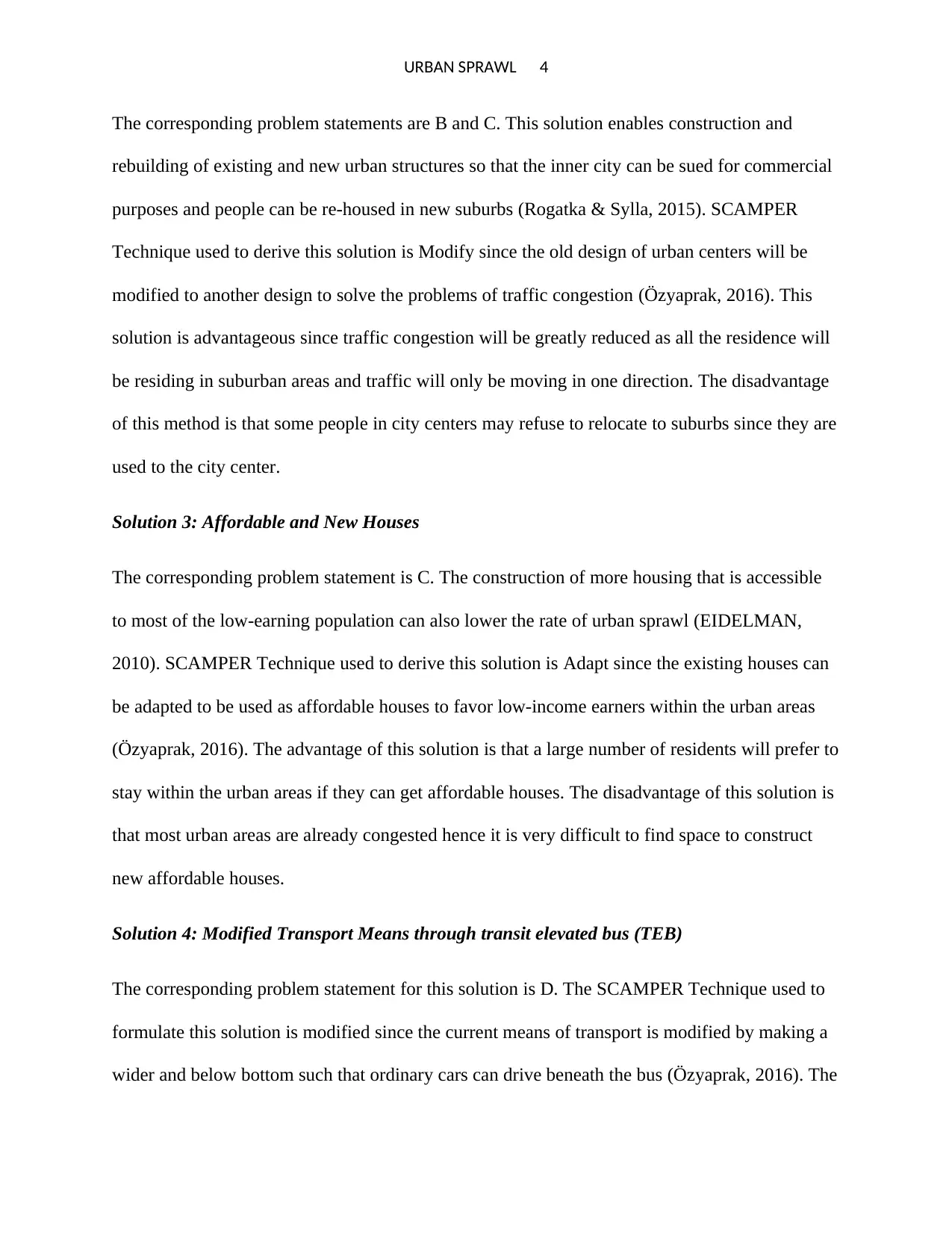
URBAN SPRAWL 4
The corresponding problem statements are B and C. This solution enables construction and
rebuilding of existing and new urban structures so that the inner city can be sued for commercial
purposes and people can be re-housed in new suburbs (Rogatka & Sylla, 2015). SCAMPER
Technique used to derive this solution is Modify since the old design of urban centers will be
modified to another design to solve the problems of traffic congestion (Özyaprak, 2016). This
solution is advantageous since traffic congestion will be greatly reduced as all the residence will
be residing in suburban areas and traffic will only be moving in one direction. The disadvantage
of this method is that some people in city centers may refuse to relocate to suburbs since they are
used to the city center.
Solution 3: Affordable and New Houses
The corresponding problem statement is C. The construction of more housing that is accessible
to most of the low-earning population can also lower the rate of urban sprawl (EIDELMAN,
2010). SCAMPER Technique used to derive this solution is Adapt since the existing houses can
be adapted to be used as affordable houses to favor low-income earners within the urban areas
(Özyaprak, 2016). The advantage of this solution is that a large number of residents will prefer to
stay within the urban areas if they can get affordable houses. The disadvantage of this solution is
that most urban areas are already congested hence it is very difficult to find space to construct
new affordable houses.
Solution 4: Modified Transport Means through transit elevated bus (TEB)
The corresponding problem statement for this solution is D. The SCAMPER Technique used to
formulate this solution is modified since the current means of transport is modified by making a
wider and below bottom such that ordinary cars can drive beneath the bus (Özyaprak, 2016). The
The corresponding problem statements are B and C. This solution enables construction and
rebuilding of existing and new urban structures so that the inner city can be sued for commercial
purposes and people can be re-housed in new suburbs (Rogatka & Sylla, 2015). SCAMPER
Technique used to derive this solution is Modify since the old design of urban centers will be
modified to another design to solve the problems of traffic congestion (Özyaprak, 2016). This
solution is advantageous since traffic congestion will be greatly reduced as all the residence will
be residing in suburban areas and traffic will only be moving in one direction. The disadvantage
of this method is that some people in city centers may refuse to relocate to suburbs since they are
used to the city center.
Solution 3: Affordable and New Houses
The corresponding problem statement is C. The construction of more housing that is accessible
to most of the low-earning population can also lower the rate of urban sprawl (EIDELMAN,
2010). SCAMPER Technique used to derive this solution is Adapt since the existing houses can
be adapted to be used as affordable houses to favor low-income earners within the urban areas
(Özyaprak, 2016). The advantage of this solution is that a large number of residents will prefer to
stay within the urban areas if they can get affordable houses. The disadvantage of this solution is
that most urban areas are already congested hence it is very difficult to find space to construct
new affordable houses.
Solution 4: Modified Transport Means through transit elevated bus (TEB)
The corresponding problem statement for this solution is D. The SCAMPER Technique used to
formulate this solution is modified since the current means of transport is modified by making a
wider and below bottom such that ordinary cars can drive beneath the bus (Özyaprak, 2016). The
Paraphrase This Document
Need a fresh take? Get an instant paraphrase of this document with our AI Paraphraser
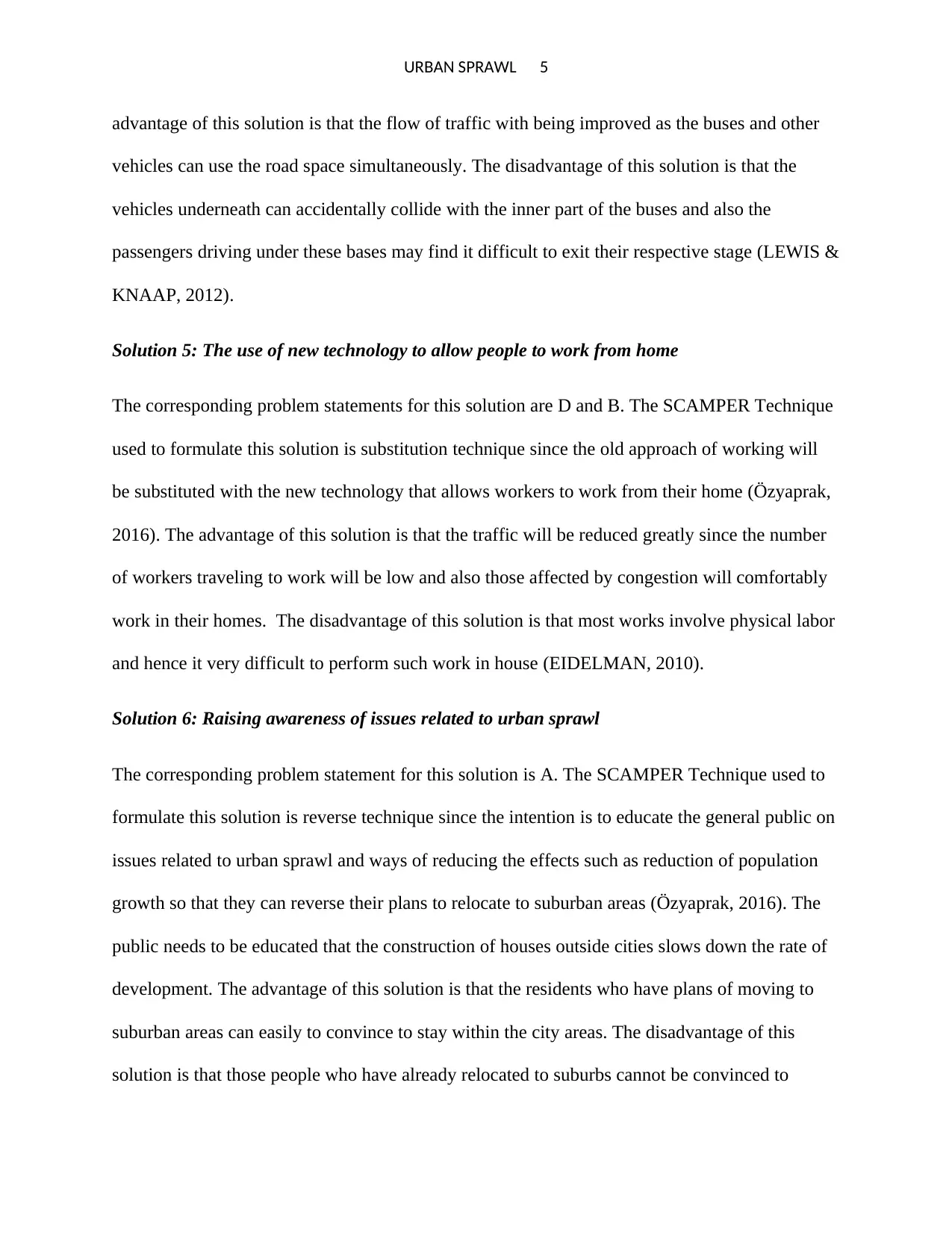
URBAN SPRAWL 5
advantage of this solution is that the flow of traffic with being improved as the buses and other
vehicles can use the road space simultaneously. The disadvantage of this solution is that the
vehicles underneath can accidentally collide with the inner part of the buses and also the
passengers driving under these bases may find it difficult to exit their respective stage (LEWIS &
KNAAP, 2012).
Solution 5: The use of new technology to allow people to work from home
The corresponding problem statements for this solution are D and B. The SCAMPER Technique
used to formulate this solution is substitution technique since the old approach of working will
be substituted with the new technology that allows workers to work from their home (Özyaprak,
2016). The advantage of this solution is that the traffic will be reduced greatly since the number
of workers traveling to work will be low and also those affected by congestion will comfortably
work in their homes. The disadvantage of this solution is that most works involve physical labor
and hence it very difficult to perform such work in house (EIDELMAN, 2010).
Solution 6: Raising awareness of issues related to urban sprawl
The corresponding problem statement for this solution is A. The SCAMPER Technique used to
formulate this solution is reverse technique since the intention is to educate the general public on
issues related to urban sprawl and ways of reducing the effects such as reduction of population
growth so that they can reverse their plans to relocate to suburban areas (Özyaprak, 2016). The
public needs to be educated that the construction of houses outside cities slows down the rate of
development. The advantage of this solution is that the residents who have plans of moving to
suburban areas can easily to convince to stay within the city areas. The disadvantage of this
solution is that those people who have already relocated to suburbs cannot be convinced to
advantage of this solution is that the flow of traffic with being improved as the buses and other
vehicles can use the road space simultaneously. The disadvantage of this solution is that the
vehicles underneath can accidentally collide with the inner part of the buses and also the
passengers driving under these bases may find it difficult to exit their respective stage (LEWIS &
KNAAP, 2012).
Solution 5: The use of new technology to allow people to work from home
The corresponding problem statements for this solution are D and B. The SCAMPER Technique
used to formulate this solution is substitution technique since the old approach of working will
be substituted with the new technology that allows workers to work from their home (Özyaprak,
2016). The advantage of this solution is that the traffic will be reduced greatly since the number
of workers traveling to work will be low and also those affected by congestion will comfortably
work in their homes. The disadvantage of this solution is that most works involve physical labor
and hence it very difficult to perform such work in house (EIDELMAN, 2010).
Solution 6: Raising awareness of issues related to urban sprawl
The corresponding problem statement for this solution is A. The SCAMPER Technique used to
formulate this solution is reverse technique since the intention is to educate the general public on
issues related to urban sprawl and ways of reducing the effects such as reduction of population
growth so that they can reverse their plans to relocate to suburban areas (Özyaprak, 2016). The
public needs to be educated that the construction of houses outside cities slows down the rate of
development. The advantage of this solution is that the residents who have plans of moving to
suburban areas can easily to convince to stay within the city areas. The disadvantage of this
solution is that those people who have already relocated to suburbs cannot be convinced to
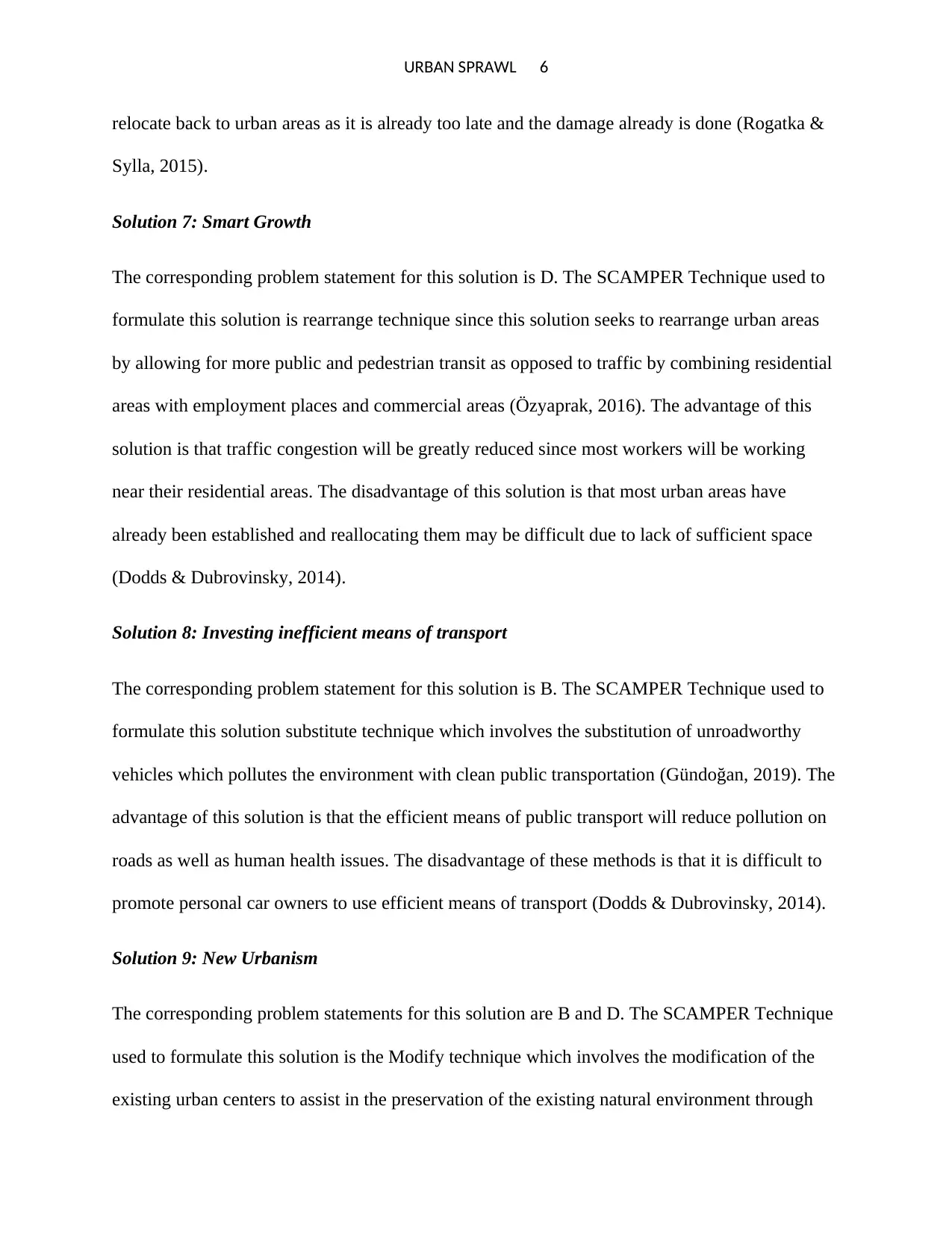
URBAN SPRAWL 6
relocate back to urban areas as it is already too late and the damage already is done (Rogatka &
Sylla, 2015).
Solution 7: Smart Growth
The corresponding problem statement for this solution is D. The SCAMPER Technique used to
formulate this solution is rearrange technique since this solution seeks to rearrange urban areas
by allowing for more public and pedestrian transit as opposed to traffic by combining residential
areas with employment places and commercial areas (Özyaprak, 2016). The advantage of this
solution is that traffic congestion will be greatly reduced since most workers will be working
near their residential areas. The disadvantage of this solution is that most urban areas have
already been established and reallocating them may be difficult due to lack of sufficient space
(Dodds & Dubrovinsky, 2014).
Solution 8: Investing inefficient means of transport
The corresponding problem statement for this solution is B. The SCAMPER Technique used to
formulate this solution substitute technique which involves the substitution of unroadworthy
vehicles which pollutes the environment with clean public transportation (Gündoğan, 2019). The
advantage of this solution is that the efficient means of public transport will reduce pollution on
roads as well as human health issues. The disadvantage of these methods is that it is difficult to
promote personal car owners to use efficient means of transport (Dodds & Dubrovinsky, 2014).
Solution 9: New Urbanism
The corresponding problem statements for this solution are B and D. The SCAMPER Technique
used to formulate this solution is the Modify technique which involves the modification of the
existing urban centers to assist in the preservation of the existing natural environment through
relocate back to urban areas as it is already too late and the damage already is done (Rogatka &
Sylla, 2015).
Solution 7: Smart Growth
The corresponding problem statement for this solution is D. The SCAMPER Technique used to
formulate this solution is rearrange technique since this solution seeks to rearrange urban areas
by allowing for more public and pedestrian transit as opposed to traffic by combining residential
areas with employment places and commercial areas (Özyaprak, 2016). The advantage of this
solution is that traffic congestion will be greatly reduced since most workers will be working
near their residential areas. The disadvantage of this solution is that most urban areas have
already been established and reallocating them may be difficult due to lack of sufficient space
(Dodds & Dubrovinsky, 2014).
Solution 8: Investing inefficient means of transport
The corresponding problem statement for this solution is B. The SCAMPER Technique used to
formulate this solution substitute technique which involves the substitution of unroadworthy
vehicles which pollutes the environment with clean public transportation (Gündoğan, 2019). The
advantage of this solution is that the efficient means of public transport will reduce pollution on
roads as well as human health issues. The disadvantage of these methods is that it is difficult to
promote personal car owners to use efficient means of transport (Dodds & Dubrovinsky, 2014).
Solution 9: New Urbanism
The corresponding problem statements for this solution are B and D. The SCAMPER Technique
used to formulate this solution is the Modify technique which involves the modification of the
existing urban centers to assist in the preservation of the existing natural environment through
⊘ This is a preview!⊘
Do you want full access?
Subscribe today to unlock all pages.

Trusted by 1+ million students worldwide
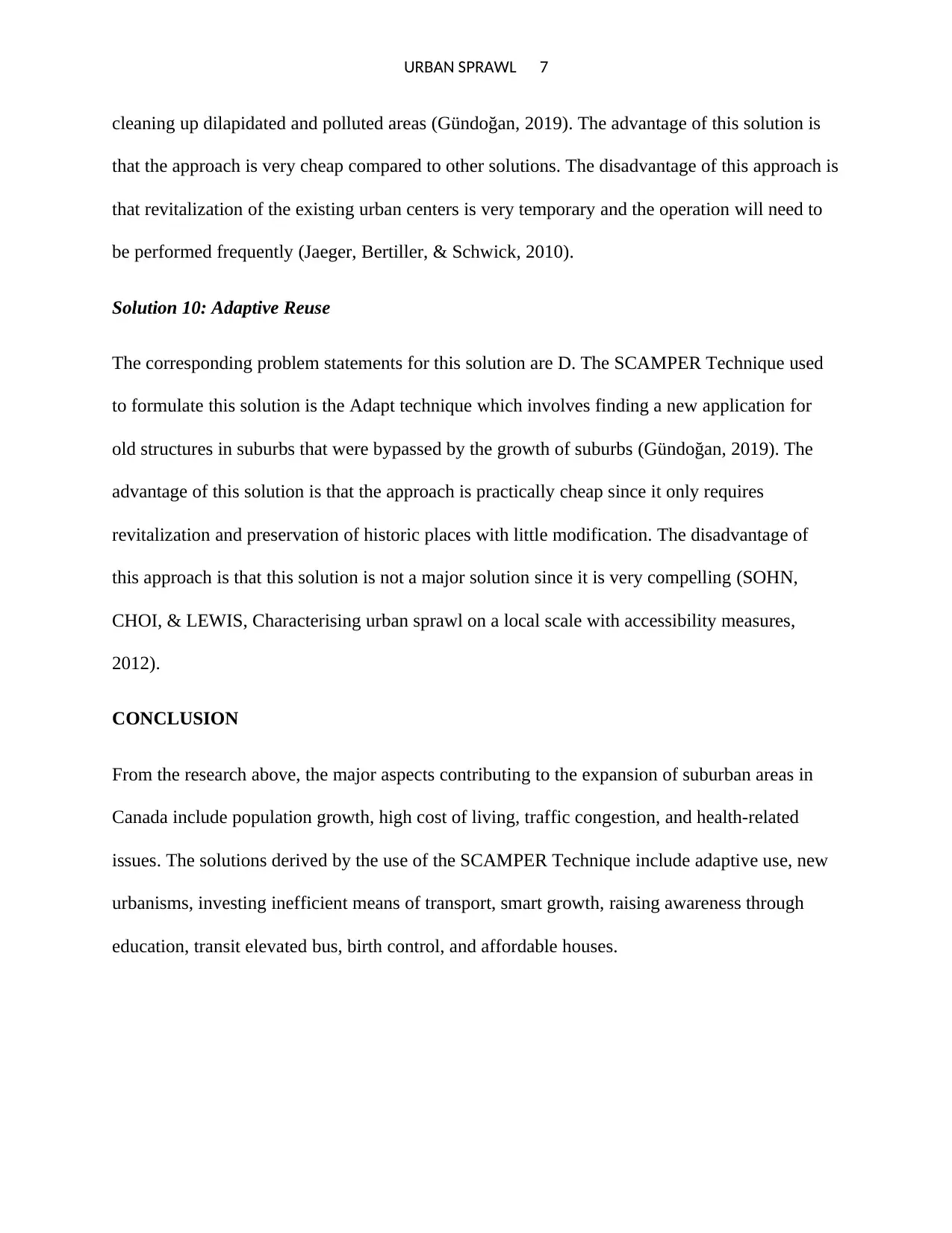
URBAN SPRAWL 7
cleaning up dilapidated and polluted areas (Gündoğan, 2019). The advantage of this solution is
that the approach is very cheap compared to other solutions. The disadvantage of this approach is
that revitalization of the existing urban centers is very temporary and the operation will need to
be performed frequently (Jaeger, Bertiller, & Schwick, 2010).
Solution 10: Adaptive Reuse
The corresponding problem statements for this solution are D. The SCAMPER Technique used
to formulate this solution is the Adapt technique which involves finding a new application for
old structures in suburbs that were bypassed by the growth of suburbs (Gündoğan, 2019). The
advantage of this solution is that the approach is practically cheap since it only requires
revitalization and preservation of historic places with little modification. The disadvantage of
this approach is that this solution is not a major solution since it is very compelling (SOHN,
CHOI, & LEWIS, Characterising urban sprawl on a local scale with accessibility measures,
2012).
CONCLUSION
From the research above, the major aspects contributing to the expansion of suburban areas in
Canada include population growth, high cost of living, traffic congestion, and health-related
issues. The solutions derived by the use of the SCAMPER Technique include adaptive use, new
urbanisms, investing inefficient means of transport, smart growth, raising awareness through
education, transit elevated bus, birth control, and affordable houses.
cleaning up dilapidated and polluted areas (Gündoğan, 2019). The advantage of this solution is
that the approach is very cheap compared to other solutions. The disadvantage of this approach is
that revitalization of the existing urban centers is very temporary and the operation will need to
be performed frequently (Jaeger, Bertiller, & Schwick, 2010).
Solution 10: Adaptive Reuse
The corresponding problem statements for this solution are D. The SCAMPER Technique used
to formulate this solution is the Adapt technique which involves finding a new application for
old structures in suburbs that were bypassed by the growth of suburbs (Gündoğan, 2019). The
advantage of this solution is that the approach is practically cheap since it only requires
revitalization and preservation of historic places with little modification. The disadvantage of
this approach is that this solution is not a major solution since it is very compelling (SOHN,
CHOI, & LEWIS, Characterising urban sprawl on a local scale with accessibility measures,
2012).
CONCLUSION
From the research above, the major aspects contributing to the expansion of suburban areas in
Canada include population growth, high cost of living, traffic congestion, and health-related
issues. The solutions derived by the use of the SCAMPER Technique include adaptive use, new
urbanisms, investing inefficient means of transport, smart growth, raising awareness through
education, transit elevated bus, birth control, and affordable houses.
Paraphrase This Document
Need a fresh take? Get an instant paraphrase of this document with our AI Paraphraser
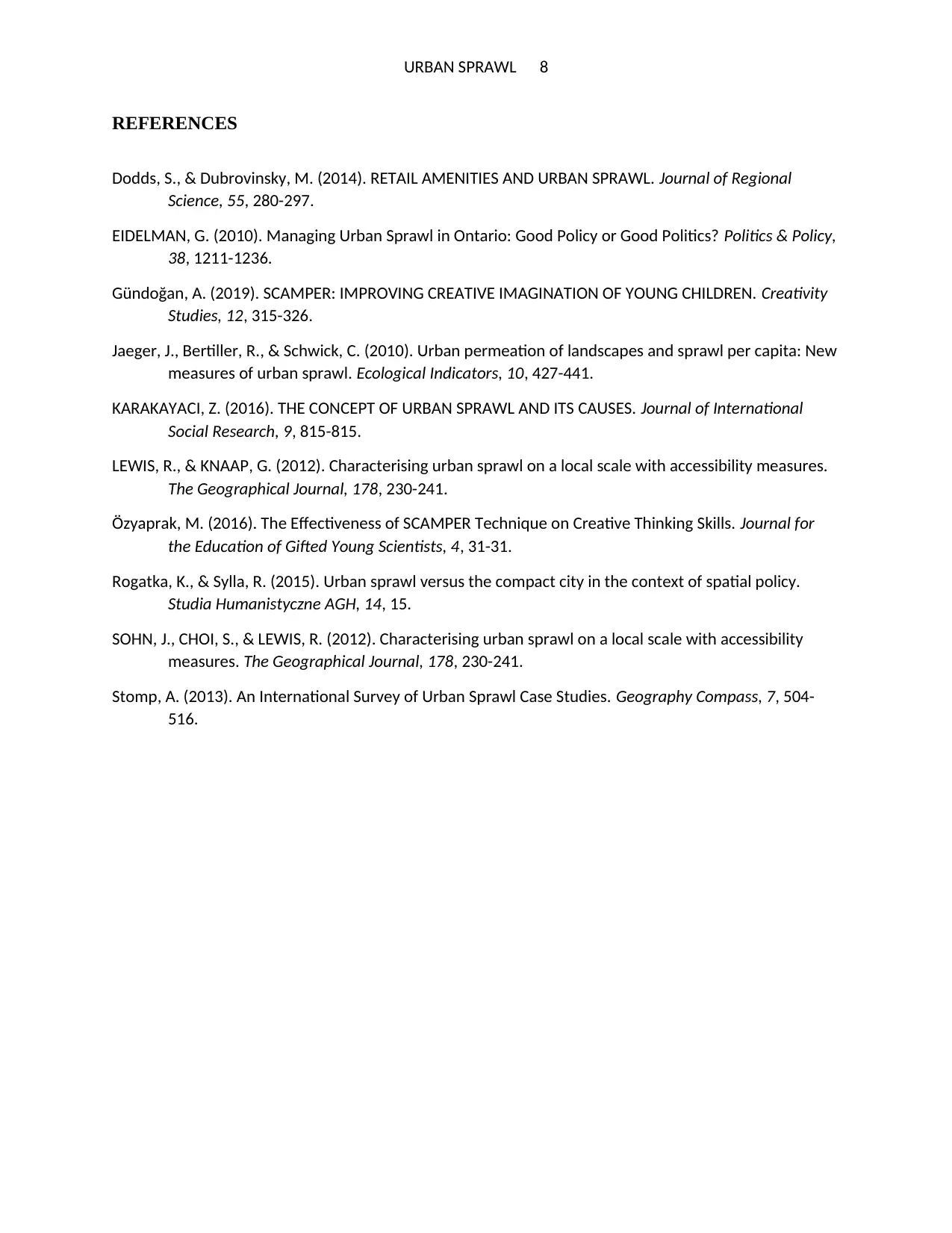
URBAN SPRAWL 8
REFERENCES
Dodds, S., & Dubrovinsky, M. (2014). RETAIL AMENITIES AND URBAN SPRAWL. Journal of Regional
Science, 55, 280-297.
EIDELMAN, G. (2010). Managing Urban Sprawl in Ontario: Good Policy or Good Politics? Politics & Policy,
38, 1211-1236.
Gündoğan, A. (2019). SCAMPER: IMPROVING CREATIVE IMAGINATION OF YOUNG CHILDREN. Creativity
Studies, 12, 315-326.
Jaeger, J., Bertiller, R., & Schwick, C. (2010). Urban permeation of landscapes and sprawl per capita: New
measures of urban sprawl. Ecological Indicators, 10, 427-441.
KARAKAYACI, Z. (2016). THE CONCEPT OF URBAN SPRAWL AND ITS CAUSES. Journal of International
Social Research, 9, 815-815.
LEWIS, R., & KNAAP, G. (2012). Characterising urban sprawl on a local scale with accessibility measures.
The Geographical Journal, 178, 230-241.
Özyaprak, M. (2016). The Effectiveness of SCAMPER Technique on Creative Thinking Skills. Journal for
the Education of Gifted Young Scientists, 4, 31-31.
Rogatka, K., & Sylla, R. (2015). Urban sprawl versus the compact city in the context of spatial policy.
Studia Humanistyczne AGH, 14, 15.
SOHN, J., CHOI, S., & LEWIS, R. (2012). Characterising urban sprawl on a local scale with accessibility
measures. The Geographical Journal, 178, 230-241.
Stomp, A. (2013). An International Survey of Urban Sprawl Case Studies. Geography Compass, 7, 504-
516.
REFERENCES
Dodds, S., & Dubrovinsky, M. (2014). RETAIL AMENITIES AND URBAN SPRAWL. Journal of Regional
Science, 55, 280-297.
EIDELMAN, G. (2010). Managing Urban Sprawl in Ontario: Good Policy or Good Politics? Politics & Policy,
38, 1211-1236.
Gündoğan, A. (2019). SCAMPER: IMPROVING CREATIVE IMAGINATION OF YOUNG CHILDREN. Creativity
Studies, 12, 315-326.
Jaeger, J., Bertiller, R., & Schwick, C. (2010). Urban permeation of landscapes and sprawl per capita: New
measures of urban sprawl. Ecological Indicators, 10, 427-441.
KARAKAYACI, Z. (2016). THE CONCEPT OF URBAN SPRAWL AND ITS CAUSES. Journal of International
Social Research, 9, 815-815.
LEWIS, R., & KNAAP, G. (2012). Characterising urban sprawl on a local scale with accessibility measures.
The Geographical Journal, 178, 230-241.
Özyaprak, M. (2016). The Effectiveness of SCAMPER Technique on Creative Thinking Skills. Journal for
the Education of Gifted Young Scientists, 4, 31-31.
Rogatka, K., & Sylla, R. (2015). Urban sprawl versus the compact city in the context of spatial policy.
Studia Humanistyczne AGH, 14, 15.
SOHN, J., CHOI, S., & LEWIS, R. (2012). Characterising urban sprawl on a local scale with accessibility
measures. The Geographical Journal, 178, 230-241.
Stomp, A. (2013). An International Survey of Urban Sprawl Case Studies. Geography Compass, 7, 504-
516.
1 out of 8
Your All-in-One AI-Powered Toolkit for Academic Success.
+13062052269
info@desklib.com
Available 24*7 on WhatsApp / Email
![[object Object]](/_next/static/media/star-bottom.7253800d.svg)
Unlock your academic potential
Copyright © 2020–2025 A2Z Services. All Rights Reserved. Developed and managed by ZUCOL.

